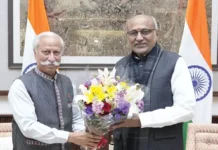Monday Musing
[ Junroi Mamai ]
After the Centre’s decision in February this year to discontinue the free movement regime (FMR) due to growing security concerns and illicit trafficking of drugs and arms, the government of India, amidst protest by the northeastern states, has started to seal the border along India and Myanmar. The border issue with our neighbouring countries has always been a sensitive geopolitical issue; however, in today’s fast commercial age, complete insularity with our neighbours seems impractical and economically unviable. Whereas, on the other side of the border China continues to upgrade its border infrastructure along with its neighbours like Pakistan, with whom it is building the Karakoram highway.
Presently, our concerns regarding issues like unchecked infiltration, drug trafficking and arms smuggling seems to be genuine considering the long-drawn ongoing civil war in Myanmar. However, Arunachal is a land-locked state with China and Myanmar on western and eastern sides. Most of our borders are still inaccessible due to the Centre’s negligence for decades in these peripheral areas; our neighbouring countries had taken advantage of this inaction, especially along the McMahon Line.
Therefore, a new multi-dimensional policy of statecraft by New Delhi is needed to address these challenging and emerging issues according to changing geo-polity of the region. Multi-pronged policies targeting border security and also redressing the economic backwardness of the people living in the border areas is the need of the hour. Our salvation lies in the economic wellbeing of local indigenous people. For how long shall we be solely depending on the central government’s aid and grants?
For economic independence, a state like Arunachal needs robust trade routes, well-connected towns and villages and better market opportunities to sell agriculture and its allied products. Tourism may also become a major source of income for the indigenous people in remote villages who mostly live below the poverty line. Trade routes can be a mitigating factor to alleviate poverty in the state. As all along the 5,131 kms long international border of the state, most areas have had existing trade routes from earliest times – one of them being the Stillwell or the Ledo road. It is a 1,726-km-long road constructed by the allied forces during the Second World War, covering Burma and upto Kunming in China. It can immensely facilitate trade both for the bordering people of India and Myanmar. Other parts of the state like Mechukha, Tawang, Anjaw and others also share a common border with China. Developing these areas with trade routes can also bring prosperity to our people.
By emulating China’s policy of developing its border area infrastructure, India can not only boost development of its border areas but also greatly enhance its border security by improving movement of armies and defence troupes.
Local people in the border areas should not be deprived of developmental activities in the name of national security by blocking trade routes and other commercial activities. As our state’s topography is very harsh and there is a dearth of alternative income sources owing to lack of industries and income generating opportunities, road infrastructure becomes an important ingredient in the overall development of the people of the state. Novel avenues of economic prosperity relating to foreign trade and commercial activities should be encouraged by the government instead of letting the state remain in complete segregation with neighbours.



